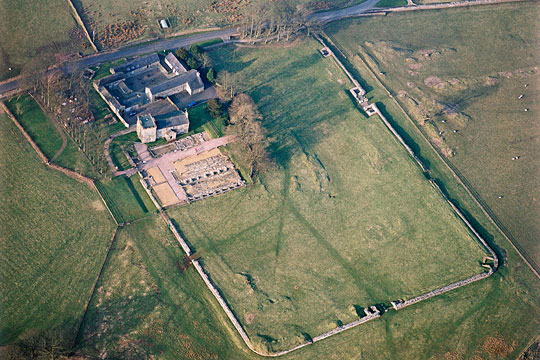Description of Birdoswald Roman Fort
The visible remains at Birdoswald bear witness to all parts of its 1,800-year history – from the complete circuit of Roman fort walls, Roman granaries and post-Roman hall buildings to the foundations of a medieval tower house, a 16th-century bastle house and a Victorian romantic landscape.

Setting
Birdoswald lies in a narrow corridor between Hadrian’s Wall to the north and, to the south, a steep cliff above a meander of the river Irthing. The views southwards from the cliff edge over the river to the hills beyond and the ridge of the Whin Sill are stunning.
FORT WALLS AND GATES
The fort was of the standard ‘playing card’ plan for Roman forts, a rectangle with rounded corners. Apart from the north-east corner, where the modern road cuts across Hadrian’s Wall, the fort walls are completely exposed. These were backed with an earth rampart and would have been some 4–5 metres high. In each corner was an angle tower, and interval towers were provided north of the east and west gates.
There were six gates, of which all but the north are visible. The four main gates – one on each side – were of a standard pattern of a double portal flanked by towers. Two additional single-portal gates were provided on the east and west sides, and are a relic of the early plan for a projecting fort like that at Chesters. The main east gate is the best preserved on Hadrian’s Wall, with one voussoir (wedge-shaped arch stone) surviving.
On the east wall there are traces of many repairs and rebuildings. Several of the towers around the fort were later used as bakehouses, and typical circular Roman ovens can be seen.
Fort Interior
The multi-layered landscape within the fort walls is a product of 1,800 years of occupation.
In the Middle Ages and later, the walls acted as a useful enclosure. As we see it today, Birdoswald is a Victorian romantic landscape. The walls were excavated in the mid-19th century to provide a classical frame for the mock-medieval farmhouse with its tower, built in 1858. The area in front of it, formerly its garden, is the part of the fort interior that has been excavated.
The fort was built across a pronounced dip, with buildings terraced uphill to north and south. Thus the south granary wall, just south of the main west gate, is 2 metres high from the original surface, but Roman ground level at the south gate is at the present surface level. The buildings have been buried by the natural movement of soil and building debris downhill through erosion.
On the rising land south of the excavated area, the east–west corrugations of medieval ridge-and-furrow ploughing are visible. To the east, substantial earthworks mark the site of the headquarters building (principia).
Within the excavated area lie the main west gate and the main street (via principalis). To the south of the street lie two substantial and well-preserved granaries (horrea). The area is laid out to show the important post-Roman timber buildings – one on the site of the north granary, and two smaller structures to the west – which are represented by modern timber posts.
To the north of the street is a long narrow building used as a workshop (fabrica) in Roman times. The medieval tower house and the 16th-century bastle house were built on top of this and their remains are visible.
Outside the fort
To east and west Hadrian’s Wall survives up to 2.5 metres high, presenting one of the better preserved stretches.
Some 325 metres west of Birdoswald is turret 49b (Birdoswald). This was built integrally with the stone Wall that replaced its turf predecessor on a more northerly line. It is not obvious from the road, which here runs along the north side of the Wall. The turret is 4 metres square internally, and survives to a height of three courses; the internal space is recessed into the thickness of the Wall. An entrance door in the south wall is offset from the south-east.
Further west two similar turrets, at Leahill and Piper Sike, can be seen on the roadside.
Milecastle 49 (Harrows Scar) lies 400 metres east above the river bridge at Willowford. Geophysical survey has shown that large settlements surrounded the fort, but there is no trace of these today. To the immediate west of the fort, medieval ridge-and-furrow masks the earlier remains.
READ MORE ABOUT BIRDOSWALD ROMAN FORT